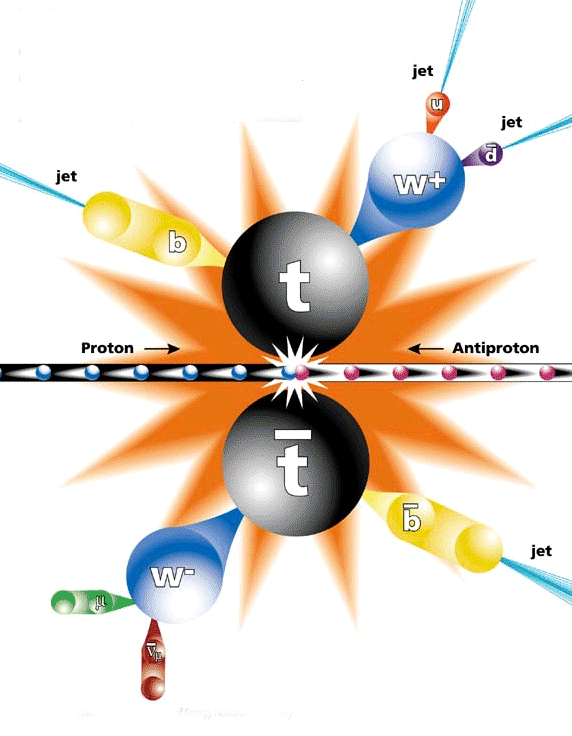 The top is produced mainly in pairs in these energetic collisions. And then the two particles -to be precise I should say the "particle-antiparticle pair"- decay at a mindboggling speed: the lifetime of the top quark, compared to a second, is much shorter than is a second compared to the lifetime of the universe. 45% of the time the decay of a top quark pair produces a final state that only features hadronic jets; nominally six of them, as there are six quarks flying out in all directions after the decay. (In the figure on the right, the top quark above the beam line decays to three jets, and the one below it decays to a jet and a lepton-neutrino pair; here we are talking of decays where also that top produces three jets instead).
The top is produced mainly in pairs in these energetic collisions. And then the two particles -to be precise I should say the "particle-antiparticle pair"- decay at a mindboggling speed: the lifetime of the top quark, compared to a second, is much shorter than is a second compared to the lifetime of the universe. 45% of the time the decay of a top quark pair produces a final state that only features hadronic jets; nominally six of them, as there are six quarks flying out in all directions after the decay. (In the figure on the right, the top quark above the beam line decays to three jets, and the one below it decays to a jet and a lepton-neutrino pair; here we are talking of decays where also that top produces three jets instead).Jets are the result of the emission of quarks or gluons from the colliding system: these particles "hadronize" by creating a stream of hadrons that travels with a direction and total energy roughly matching that of the originating body. We measure the jets in our detector, and use the result to infer the properties of the collision.
Now, twenty years ago I participated in the analysis which first obtained a signal of the all-hadronic decay of top quark pairs: this signal was difficult to extract from the data because it is riddled by a huge background from quantum chromodynamical processes that have nothing to do with top quark production, but which produce many jets as the signal does.
The analysis we performed was difficult because of the large background and the small signal we were looking for, but in the end we did manage to extract a significant signal. The first observation of "all-hadronic" top pair decays was published in Physical Review Letters in 1997.
It feels funny that 20 years after that result I am still trying to repeat the feat, this time with CMS data. The reason is no longer that of studying the top quark, though: I am interested in a totally different process, namely the production of Higgs boson pairs. The Higgs may decay to pairs of b-quark jets, and the HH final state I am focusing on is indeed one where both Higgs boson produce two b-jets. So we have four jets, with which we try to reconstruct the Higgs boson mass.
Since the correspondence between a quark and the jet that we measure in the CMS detector is a loose one, there is a calibration issue to consider. Imagine there is a class of people who weighs exactly 92 kg, and you want to verify how many of them are includediin a sample of people whose weights you have recorded in a file. You draw the histogram of weights, and look for the bin corresponding to 92 kg. Now, if the scale you used in your measurement is biased -say it reports a weight 2 kg higher than the real one - you are going to draw a false conclusion on the presence of 92-kg people in your dataset!
Similarly to people of 92 kg, the Higgs boson has a well-defined mass, 125 GeV. However, as we measure it with a potentially imperfect scale (our detector), we need to ascertain that it does return 125 GeV for a 125 GeV particle decay. To check for a miscalibration, what I do is to search for top quarks in the same dataset. I do know the mass of the top quark (173 GeV), and I also know that there are many top quark events in the data. By spotting them, and observing whether I measure them at the right mass value or if instead I measure them a bit high or low, I can calibrate the jet energy measurement, reducing any uncertainty due to that measurement in the search for Higgs boson pairs. Note that I cannot do that with the Higgs signal, as it is so small that I cannot rely on it as a calibration point.
 The above is easier said than done, of course. As I am currently spending my vacations in the tiny and beautiful island of Elafonisos, in the southern Peloponnese (see picture above, credit yourgreekisland.com), my time on this task is a bit limited. However, I am trying to get a result out in time to include it in the HH analysis that my group is carrying out in CMS... Alas, I wish Elton John were right when he sung "And all that science, I don't understand - it's just my job five days a week"!
The above is easier said than done, of course. As I am currently spending my vacations in the tiny and beautiful island of Elafonisos, in the southern Peloponnese (see picture above, credit yourgreekisland.com), my time on this task is a bit limited. However, I am trying to get a result out in time to include it in the HH analysis that my group is carrying out in CMS... Alas, I wish Elton John were right when he sung "And all that science, I don't understand - it's just my job five days a week"! 



Comments